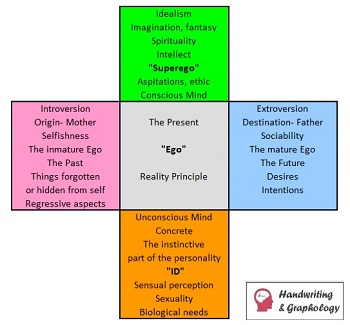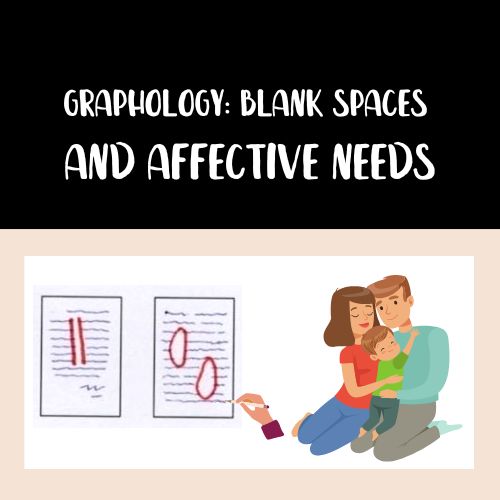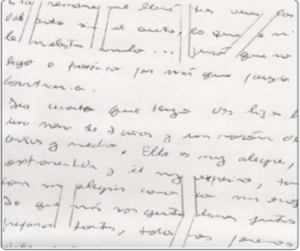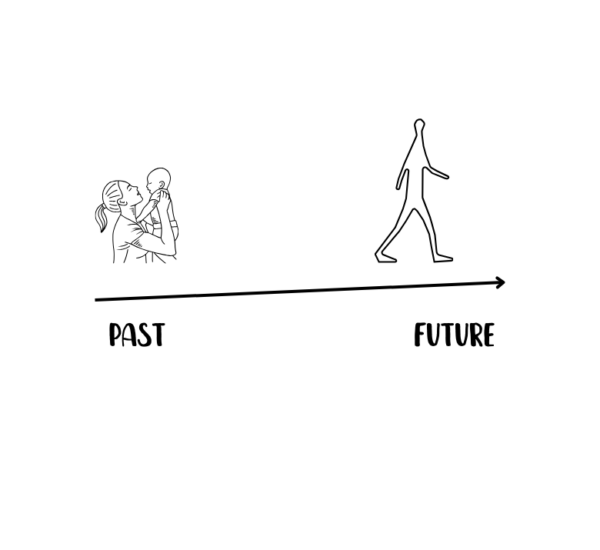For Graphology, blank spaces speak to us as much as the written text. But… what do they tell us? When we communicate verbally, silences are as revealing as words. The analysis of the blank spaces we unconsciously leave is as important as analyzing the text.
What are blank spaces?
In a text, there are blank spaces between words, between letters, in the margins, and there are also spaces that appear blank within the text. These masses of blank spaces are areas of unconscious omission. Out of the four margins, especially the top and left margins, are considered the most “conscious of all”.
Affective Needs in Handwriting Analysis
Blank spaces are related to the affective needs of human beings. Within the so-called vital needs is the function of nourishment. Without food, there is no life. Therefore, affective needs are as important as the food and air we breathe. We cannot do without food or the affection of other human beings to achieve physical and mental well-being.
In reality, not everyone needs the same things. Dietary requirements, like the need for affection, differ for each individual. Eating disorders (such as anorexia and bulimia) demonstrate that there is an intimate relationship between food and affection. Let’s explore this topic applied to graphology.
The need and intensity of affection are related to each person’s history and personality structure. Human beings need to feel accepted, understood, respected, recognized, and listened to. Depending on how each individual “lives” these needs, they will manifest the degree of independence or dependence on others. This is reflected in their way of writing.
What is the “expected” Spacing in Writing?
The module indicates:
• The normal space from letter to letter within a word should be equal to the width of the ovals in the letters a, o, g, d. The spacing between letters indicates affective needs and the degree of dependence in intimate relationships.
• The normal space between words should be equivalent to the width of the letter m. This space between words indicates how we connect with our non-familiar or intimate daily environment.
• The normal distance between lines should be equal to three times the height of the letter m.
IMPORTANT: In no case should the lower parts of the letters (descenders) overlap with the upper parts (ascenders) of the next line.
These “overlaps” that may appear are called “axis collisions.” When a part of a letter “invades” another from the previous or next line, it denotes the presence of some kind of conflict in the writer. As we always clarify, it is necessary to analyze in which letters it occurs, the intensity (how many times they overlap), and the graphic context.
By separating letters and words, we express our moods, fears, presence of conflicts… in short, our personality.
Classification based on spacing in a text
Writing can be classified as: Normal, spaced, or concentrated.
Normal Spacing
Normal spacing occurs when the spaces align with the module. It signifies self-control of emotions, and the need for emotional connection with others is lower.
Wide Spacing
If the space between letters is greater than the module, we say that it is spaced writing. It implies difficulty in emotionally connecting, independence, and a tendency towards isolation.
Narrow Spacing (Concentrated Writing)
Writing is considered concentrated when there is little space between the letters. The person is introverted, reserved, and has difficulty expressing their emotions.
When peculiarities appear and letters “stick” or adhere to others, overlap, or their normal connection disappears, it indicates that the person is very demanding, dependent, overly attached, and invades others’ boundaries. As we emphasize in every article, we should always consider the entirety of the graphic environment and not just isolated signs.
In this section, we present the topics in a simplified manner that those interested in Graphology should know to understand the rest.
Shape of Blank Spaces in Text with Meaning
Sometimes, the blank spaces in a written text take on different shapes. Gaps may occur that form columns of two or three lines. They reveal the attitude of closeness or distance towards others, the external world, and the future. When this is repeated several times in different directions, they are referred to by various names: knives, ghosts, bags, waterfalls, chimneys, and they are highly valuable for graphological analysis.
Knife-Shaped Blank Spaces
They refer to the margins within the text that occur because the space between words is larger than the module. They extend three lines downward, forming diagonal columns known as knives or chimneys. They are interpreted as signs of anxiety, restlessness, insecurity, which may be transient. In this case, the symbolism of Max Pulver’s space also applies.

• When they point to the left, the person feels distressed, suffers, becomes depressed, and fails to overcome the conflict, turning inward. • On the other hand, if the chimneys or knives point to the right, it means that the person relies on their environment and friendships, finding a satisfactory solution to the conflict.
• When the blank spaces in the text are vertical, the conflict may be internal.
Please note that while graphology can provide insights, it is not a scientifically validated method and should be approached with caution.
Blank Spaces in the Form of “Bags”
They are called bags when the spaces repeat for more than three lines, cascading within the text. They are interpreted as deep subconscious distress. When they occur with slow, monotonous, and vertical writing, they are associated with a tendency towards obsessive neurosis. We will continue to delve into these topics in articles on graphopathology.
Blank Spaces in the Form of “Ghosts”
They are similar to bags but appear at the edges, and their meaning depends on their specific location.
• When they are in the right margin at the end of the lines, resembling a bite, they are interpreted as insecurity about the future that “paralyzes” in the face of the unknown.
• When they appear at the top of the text, the insecurity is conscious. They symbolize fear and anxiety about a decision to be made.
• In contrast, when they appear at the bottom, the fear is unconscious, related to something that cannot be achieved.
This concludes the article on blank spaces in graphology and affective needs. Keep browsing this website to learn more about Tips for a positive signature, and the meaning of slanted handwriting.








